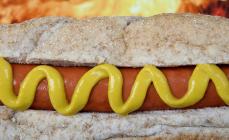Plan
1. Arctic deserts
2. Tundra
3. Forest zone
a) taiga
b) mixed forests
c) deciduous forests
4. Steppes
5. Desert
6. Subtropics
Arctic deserts
Arctic - This is a zone of islands lying near the North Pole. Here there is a long, cold winter, a short cold summer, and therefore the vegetation is scarce - mosses and lichens.
In the Arctic, the sun does not set for several months - the polar day continues. For several months it is light all day, but not warm. The temperature is only a few degrees above 0. In winter, the polar night sets in. It is dark and very cold. The darkness is illuminated by the moon, stars and the Northern Lights.
This is a very cold area. But this does not mean that there are no animals and plants on it.
Arctic - the kingdom of the polar bear. The lack of land does not bother him, the main habitat is the ice floes of the Arctic Ocean. Polar bear eats fish, hunts seals, seals, and baby walruses.
Numerous pinnipeds also live in the Arctic - seals, seals, walruses, elephant seals. The elongated streamlined shape of the body helps them to move in water at great speed.
On the coastal rocks, numerous birds find shelter and nest in the summer; In the cracks of rocks, where a small amount of soil accumulates, in thawed areas of glacial deposits - moraines, mosses, lichens, some types of algae and even cereals and flowering plants settle near snowfields. Among them are bluegrass, cotton grass, polar poppy, sedge, dwarf willows, birches. During the cold polar summer, they manage to bloom and even bear fruit.
Unfortunately, due to the development of the Arctic by man, difficult ecological problems: pollution northern seas; destruction of commercial fish species; hunting for polar bears and seals. Now hunting rare animals in the Arctic is prohibited. Some bird colonies have been taken under protection. Limited fishing... Reserves have been created, for example, the reserve "WRANGEL ISLAND"
Tundra
The tundra climate is harsh - winter lasts longer than academic year at school. All year round fierce winds blow and blizzard rages in winter. Even in summer, the ground practically does not thaw (only by 10 - 25 cm), and below the permafrost remains.Birch trees spread near the surface, hiding from the wind and cold in mosses and lichens.
The ptarmigan, snowy owl, gyrfalcon, reindeer, wolves constantly live in the tundra; geese and cranes arrive in the summer.
The main occupation of the tundra population is reindeer herding. Extraction of minerals is still underway - oil and gas.
Environmental problems have arisen in the tundra:
disturbance of the soil from the caterpillars of tractors, all-terrain vehicles - plants die.
the area is polluted with oil during its production.
illegal hunting - poaching.
reindeer pastures are trampled down because the reindeer are not always driven to other places.
Forest zone
Taiga – coniferous forest, it occupies most of the zone.
Mixed forest - along with conifers birch, aspen, alder grow. Winter is milder in such a forest. Deciduous trees have medium-sized leaves, which they shed for the winter.
Broadleaf forest - replaces oak, linden, maple, ash, elm. These are heat-loving plants, so they have large leaves, shed their foliage for the winter, and multiply by seeds.
Through the fault of man arise ecological problems ... If earlier the forest was cut down as needed, now everything that is possible is cut down. Excessive hunting has led to the complete or almost complete extinction of some species of animals.
Steppe
The steppes stretch in a narrow continuous strip in the south of Russia from the western borders to Altai. Further to the east, the steppe areas have focal distribution.average temperature January at the start of -2 ° С, and in the east -20 ° С and below. Summer in the steppe is sunny and hot. The average July temperature is 22-23 ° C. Thaws often occur in the west of the zone, so the snow cover there is thin and very unstable. The dominant steppe soils are chernozems.
Natural plant communities are represented mainly by perennial, drought and frost-resistant grasses with a powerful root system. These are, first of all, cereals: feather grass, fescue, wheat grass, serpentine, thin-legged, bluegrass. In addition to cereals, there are numerous representatives of forbs: astragalus, sage, carnation - and bulbous perennials, for example tulips.
In the European steppes, the basis is made up of narrow-leaved grasses: feather grass, fescue, bluegrass, fescue, thin-legged, etc.
In the more arid southern regions, in addition to cereals, wormwood, breast milk, and cinquefoil are common. There are many tulips in the spring. In the Asian part of the country, tansy and cereals predominate.
Ungulates are adapted to long-term movements across the endless expanses of the steppes. Due to the thinness of the snow cover, plant food is available in winter as well. Bulbs, tubers, rhizomes play an important role in nutrition. For many animals, plants are also the main source of moisture. Typical representatives of ungulates in the steppes are turs, antelopes, tarpans. However, most of these species result in economic activity people were exterminated or driven south. Saigas, which were widespread in the past, have survived in some areas.
Of the rodents, the most common are the gopher, vole, jerboa, and others. Ferre, badger, weasel, and fox also live in the steppe.
Of the birds, the bustard, little bustard, partridge, steppe eagle, buzzard, and kestrel are typical of the steppes. However, even these birds are now rare.
There are much more reptiles than in the forest zone. Among them, we single out the steppe viper, snake, common snake, nimble lizard, shitomordnik.
The wealth of the steppes - fertile soil ... This natural area almost completely developed by man and natural steppe landscapes are preserved only in reserves. Due to insufficient quantity atmospheric precipitation and frequent droughts in the steppe zone are built irrigation systems.
Steppe - a zone of developed animal husbandry. Cattle, horses and poultry are bred here. Various industries are developed: metallurgy, mechanical engineering, food, chemical, textile.
Desert
In Russia, the desert occupies a small area - along the shores of the Red Sea. Huge deserts are spread out in other states: Kazakhstan, Turkmenistan, Uzbekistan. It's very hot in the desert.Typical soils of the semi-desert and desert zone are chestnut.
Most desert animals are small because they have nowhere to hide from predators. The most common reptiles are lizards, snakes, and turtles.
Birds - bustard, little bustard, lark.
Of the most large mammals note the camel, the saiga; there are korsak, wolf.
Camel
- he has many adaptations to live in the desert. Long, thick eyelashes protect the eyes from sand. Both toes on each foot are connected by a corpus callosum. Thanks to her, he does not fall into the sand.
The traditional occupation of the population is cattle breeding: sheep, camels, cattle are raised. As a result of overgrazing, the area of unsecured scattered sand increases. One of the measures to combat the onset of the desert is phytomelioration - a set of measures for the cultivation and maintenance of natural vegetation.
People built canals to irrigate the land. It's good. But excessive irrigation led to the fact that there was a lot of salt in the soils. Poaching is also a problem.
The culprit of the created problems is a person. Now people are faced with a difficult task - to correct their mistakes.
Subtropics
This zone, which occupies the Black Sea coast of the Caucasus, is characterized by the smallest extent and area in Russia.Fertile red earth and yellow earth soils are widespread.
Subtropical vegetation rich and varied. Vegetable world represented by evergreen rigid-leaved trees and shrubs, among which we will name boxwood, laurel, cherry laurel. Oak, beech, hornbeam, maple forests are widespread. Thickets of trees intertwine with liana, ivy, wild grapes. There are bamboo, palms, cypress, eucalyptus.
Among the representatives of the animal world, we note the chamois, deer, wild boar, bear, pine and stone marten, Caucasian black grouse.
The abundance of warmth and moisture allows the cultivation of such subtropical crops as tea, tangerines, lemons. Large areas are occupied by vineyards and tobacco plantations.
Favorable climatic conditions, the proximity of the sea and mountains make this area a large recreational area of our country. There are numerous camp sites, rest houses, sanatoriums.
Views: 57 467
You may be interested

What the world? It would seem like a simple question that even a child in first grade can answer. However, it is worth digging a little deeper - and it turns out that in reality everything is much more complicated. And the older and more educated a person is, the more complicated his version of the answer.
The reason for this is the great intellectual leap that humanity has made on the path of its evolution. Many religious movements, philosophical schools and scientific theories have given us the opportunity to change the interpretation of the answer to this question at our own discretion. Therefore, let's ourselves try to find out what the world around us is in reality.
Truth in simplicity
To begin with, we will consider this issue, proceeding from the logic of an ordinary person, without delving into the subtle matters of the universe. So, the world around us is the space that surrounds us. And it is at this moment that the first controversial statements appear.
If you figure it out, it is quite difficult to outline the boundaries that separate one space from another. After all, there are no specific standards capable of organizing all this knowledge in the head of billions of people. In this regard, if we ask the usual question about what the world around us is, we will get different answers.
For example, for some it may be the space that surrounds them directly. For others, everything is much more complicated, and by this concept they mean our entire planet or even the Universe.
The world around us: wildlife
However, despite all the variety of answers, there are those that can be distinguished into a separate group. This is due to the fact that, despite minor differences, they still have some similarities leading to a common idea.

In particular, many believe that the world around us is all living things around us. The same forests, fields, rivers and deserts. Animals and plants are also included here, as they are an integral part of this world.
What is the world around us through the eyes of philosophers?
Philosophers and theologians consider this issue more deeply. After all, for them our world is part of a more complex reality. For clarity, let's consider the main features of their views on the current order of things.
According to religion, our reality is a place where people live only part of the path prepared for them. That is, the world around us is just a screen that covers more a nice place- Paradise.
As for the philosophers, they are more vague in formulating the answer to this question. Depending on the school, the thinker can define the concept of the surrounding world in different ways. For some it is a material place, for the second it is spiritual, and for the third it is a combination of the two previous ones.
The subject "The World Around" in primary school lays the foundations for the development of children's cognitive interest in such natural and social sciences as geography and biology, physics and chemistry, history and social science. This subject has become a rethinking and addition to the previous school course in natural history. It is designed to teach children to a holistic, rational comprehension of the very world around us in which we live.
This thematic section contains ready-made synopses of lessons, project activities, integrated lessons, extracurricular activities around the world in primary school. The range of topics presented is very wide. It covers the entire curriculum of the course and is not limited to it.
Examples of lessons from the world around them - to help teachers.
Contained in sections:Includes sections:
Showing publications 1-10 of 320.
All sections | The world
Critical thinking techniques in the lessons of the Russian language and the world around Reception of writing syncwines. The changes taking place in modern education, put forward as a priority the problem of using new technologies of teaching and upbringing. In Russian lessons, literary reading, the surrounding world, at the stage of mastering new knowledge, you can ...
Development of a lesson on the outside world in grade 4 "Life of the ancient Slavs in the time of Ancient Russia" Theme. The life of the ancient Slavs. In times Ancient Rus. Target: educational: to form in students an idea about Ancient Russia, Russian princes, about the life of the ancient Slavs, their religion; developing: develop students' oral speech, imagination, fantasy, ability to work with ...
The world around us - "Travel to the country of road signs". Summary of the lesson of the surrounding world using game technology in 2.4 classes
Publication "Travel to the country of road signs". Summary of the lesson surrounding ... " Municipal educational institution "Staropolskaya secondary school" The world around us: a lesson with the use of game technology in grades 2, 4 Prepared and conducted by: primary school teacher Khozyainova EV Objectives: 1. Expand students' knowledge of the rules of behavior on the road. 2. Cultivate feeling respectful attitude to my...
Library of images "MAAM-pictures"
Summary of the lesson on the world around in grade 3 "The Golden Ring of Russia" Lesson summary on the topic "The Golden Ring of Russia" Purpose: the formation of the foundations of civic identity, a sense of pride in their homeland. Objectives: 1. To expand the knowledge of children about the cities of the Golden Ring. 2. Learn to recognize the city by its main attractions and reproduce in ...
Test on the outside world "Wise choice", grade 4, the world around, UMK A. A. Pleshakova, M. Yu. Novitskaya ("Perspective") Test "Wise choice" 1. In what year did the baptism of Rus take place? a) in 862 b) in 1157 c) in 988 2. The great Kiev prince who baptized Rus. a) Prince Vladimir b) Prince Yuri Dolgoruky c) Prince Yaroslav the Wise 3. Day ...
Verification work on the surrounding world "The beginning of the Moscow kingdom", grade 4 UMK AA Pleshakov, M. Yu. Novitskaya Verification work "Beginning of the Muscovy" Surname _ 1. How was the Grand Duke's throne passed on? _ 2. Why did the Russian people fled to uninhabited areas - to the steppe, to the river islands of the Don, to the Volga Zhiguli mountains? _ _ 3. What was the name of the free ...
The world around us - Summary of a lesson on the outside world for class 1 "Useful products with your own hands"
Theme: " Healthy foods do it yourself "Purpose: - to promote the formation of children 's ability to conduct cognitive - research activities. Tasks: 1. Using research activities find out what benefits milk brings to the child's body. 2. Promote ...
Theoretical foundations of the formation of research competencies in the classroom on the subject "The World Around" The problem of educational research activity has deep roots. Foreign teachers (J.-J. Rousseau, I. Pestalozzi, F. Disterweg, G. Kershenshteiner, J. Dewey, S. Frene) expressed the idea of encouraging the child to cognize the world through research and discoveries. In Russia, this position ...
The world around you is one of the most interesting and exciting lessons in elementary school. This is the world around us, these are animals and plants, this is space, the whole universe is in the palm of our hand. The child begins to understand the peculiarities of its functioning, learns how everything happens in this world. The world around us in primary school 1, 2, 3, 4 is a preparation for the child's understanding of such subjects as biology, physics, chemistry, astronomy, physics. This is a necessary knowledge base. To build up a good base, you need to read a lot, and parents need to work with their child. In the classroom will help methodological manuals, which you can download and print free of charge from our website.






